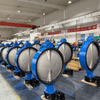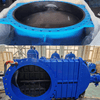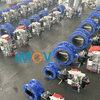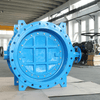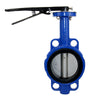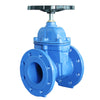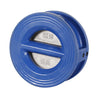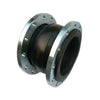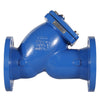A Complete Guide to Gear Operated Butterfly Valves
In the field of industrial fluid control, butterfly valves are favored for their simple structure, quick operation, and relatively low flow resistance. However, when dealing with large diameters or high differential pressure conditions, manual operation with a simple handle is often insufficient.
In such cases, the butterfly valve gearbox becomes an indispensable power transmission component. It not only provides a reliable means of reducing operating effort but also plays a crucial role in enabling automation and ensuring system safety. This article takes a closer look at the different aspects of butterfly valve gearboxes.
butterfly valve gearbox parts

Advantages of Gear-Operated Butterfly Valves
The gearbox of a butterfly valve plays a crucial role by transforming a relatively small input force into a much larger output torque. Its importance becomes evident in several key aspects:
-
Handling High Torque
When the valve size exceeds DN300—or even at smaller diameters under high differential pressure—the resistance acting on the disc is significant. Operating the valve directly with a lever becomes difficult, if not impossible. A gearbox, through torque multiplication, allows operators to open and close the valve with ease. -
Suitable for Frequent Operation
In systems where flow must be adjusted regularly, relying on manual levers is both inefficient and physically demanding. The gearbox provides smoother, lighter operation, reducing operator fatigue and improving overall efficiency. -
Enabling Precise Control
Thanks to its high gear ratio, the gearbox allows fine-tuned adjustments of the disc angle, sometimes as precise as one degree or less. This level of accuracy is especially valuable in HVAC applications and other systems that require strict control of flow and temperature. -
Enhancing Safety
Rapid valve operation can cause dangerous “water hammer” effects, leading to shocks within the pipeline system. The gearbox’s reduction mechanism ensures gradual opening and closing, effectively eliminating water hammer. It also protects internal components, such as the stem and sealing elements, from damage caused by excessive force.
What’s the Difference Between Gear-Operated and Handle-Operated Butterfly Valves?
When selecting a butterfly valve, the choice of operating method is one of the most fundamental decisions. Put simply, a gear-operated butterfly valve is a standard valve equipped with a gearbox and handwheel (often with a pointer and dial) to control the stem, while a handle-operated butterfly valve relies on a direct lever for actuation. Their key differences are summarized below:
|
Aspect |
Handle Butterfly Valve |
Gear-Operated Butterfly Valve |
|
Operating Method |
Direct actuation by lever |
Handwheel + gearbox transmission |
|
Suitable Size Range |
Small diameters (DN50–DN200) |
Medium to large diameters (DN250 and above) |
|
Operating Force |
Requires more effort; the larger the size, the harder it is to operate |
Gear reduction makes operation smoother and less strenuous |
|
Control Precision |
Primarily for open/close; limited accuracy in regulation |
Allows gradual opening/closing with finer angle adjustment |
|
Space Requirement |
Lever requires swing radius but remains relatively compact |
Gearbox increases overall height and footprint |
|
Cost |
Lower cost, suitable for general pipelines |
Higher cost, but more reliable for critical applications |
|
Typical Applications |
Building services, HVAC water systems |
Water treatment plants, power plants, petrochemical, wastewater systems |
Main Types of Butterfly Valve Gearboxes
Depending on their structure and drive mechanism, butterfly valve gearboxes can generally be divided into the following types:
-
Worm Gear Type
The most common and cost-effective design. A worm drives the gear to achieve a 90° rotation, providing excellent self-locking capability. This ensures the valve remains securely in position and will not shift due to fluctuations in medium pressure. -
Planetary Gear Type
Typically used for extra-large diameters (DN800 and above) or high-pressure applications. Its compact structure, high transmission efficiency, and large torque output make it well suited for heavy-duty conditions. Although more expensive, it is widely applied in power plants, petrochemical facilities, and other critical pipeline networks. -
Actuator-Compatible Type
These gearboxes are designed with standardized interfaces (such as ISO 5211) on the top, making it easy to mount electric, pneumatic, or hydraulic actuators for remote automatic control. At the same time, they retain manual operation capability, ensuring safe operation even during emergencies such as power failures.
Additional Feature: Chain Wheel Operation
When valves are installed at high or hard-to-reach locations, a chain wheel attachment can be added to the handwheel. The chain forms a long loop hanging at an accessible height, allowing operators to open the valve by pulling one side of the chain and to close it by pulling the other—enabling safe and convenient ground-level operation.

Key Selection Parameters for Butterfly Valve Gearboxes
Choosing the right gearbox is essential to ensure long-term, stable operation of a butterfly valve. The following parameters should be carefully evaluated:
-
Torque Output Range
The gearbox must provide sufficient output torque to cover the valve’s operating requirements under maximum differential pressure, with an added safety margin. This prevents gearbox overload caused by fluctuations in operating conditions. -
Gear Ratio
The gear ratio determines both the number of turns required and the amount of output force. A higher ratio makes operation easier by reducing effort, but it also means more turns are needed to fully open or close the valve. -
Materials and Protection Rating
Common housing materials include cast iron, ductile iron, and stainless steel, the latter being preferred in corrosive environments. Protection ratings (IP codes) are equally critical—for example, IP65 indicates dust-tight protection and resistance to water jets, while IP67 allows temporary immersion in water, making it suitable for outdoor, humid, or wash-down applications. -
Mounting Standards
Standardized mounting interfaces, such as ISO 5211, ensure compatibility and interchangeability between the gearbox, valve, and actuator. This simplifies procurement, installation, and future maintenance.
Selection Guide
When choosing the right gearbox for your butterfly valve, the following steps can serve as a practical guide:
- Consider Valve Size and Pressure
For low-pressure butterfly valves up to DN250, a simple handle may be sufficient. However, for DN250 and above—or any valve operating under high differential pressure—a gearbox is strongly recommended to ensure safe and reliable operation. -
Assess the Operating Environment
In corrosive environments such as coastal areas or chemical plants, a stainless steel housing is preferable. For outdoor installations, always select products with a protection rating of at least IP65 to safeguard against dust and water ingress. -
Balance Budget and Maintenance Needs
Worm gearboxes are cost-effective and suitable for most applications, making them the standard choice. Planetary gearboxes, on the other hand, deliver superior performance and durability, making them ideal for heavy-duty or high-end projects.

FAQs and Maintenance
Q: Can a gearbox fail?
A: Yes. The most common wear occurs on the contact surfaces between the worm and worm gear. Inadequate lubrication is the primary cause of failure.
Q: What should I do if the gearbox seizes or becomes inoperable?
A: First, check whether the valve itself is jammed by debris. If the valve is functioning normally, the issue is likely due to dried-out grease or gear wear/corrosion inside the gearbox. In such cases, do not attempt to force the operation; the gearbox should be disassembled and inspected by qualified personnel.
Maintenance Recommendations
- Regular Inspection: Visually inspect the gearbox housing and seals at least every six months.
- Routine Lubrication: Follow the manufacturer’s guidelines for lubrication, applying the specified grease and cleaning out old residues as needed.
- Avoid Immersion: Even with higher protection ratings, gearboxes should not be left submerged in water for prolonged periods.
Although a butterfly valve gearbox is technically an accessory, its importance is on par with the valve body itself. Acting as the link between manual (or powered) input and the valve, it directly influences the operability, precision, and safety of the entire fluid control system. For this reason, proper gearbox selection should never be overlooked.
At Union Valve, we understand the critical role a well-matched gearbox plays in system reliability. Alongside our full range of high-quality butterfly valves, we offer gearbox solutions tailored to your specific conditions—whether diameter, pressure, medium, or environment. Our team can recommend or customize the most suitable gearbox to ensure stable, reliable, and efficient operation across all applications. Please feel free to contact our technical experts for one-stop selection support.

